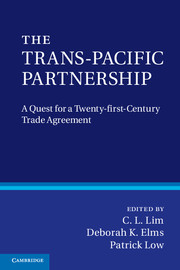Book contents
- Frontmatter
- Contents
- List of Figures and Tables
- Contributors
- Preface
- Acknowledgements
- Disclaimer
- Glossary
- Part I Introduction
- Part II The past: origins of the TPP Agreement
- Part III The present: twenty-first century elements and obstacles
- 6 Negotiations over market access in goods
- 7 TPP negotiations
- 8 Trade in services
- 9 TPP Agreement
- 10 The intellectual property chapter in the TPP
- 11 Regulatory coherence in the TPP talks
- 12 Environmental issues in the TPP
- 13 Labour standards and the TPP
- 14 What is to be done with export restrictions?
- Part IV The future: high-quality meets regional and global realities
- Part V The TPP negotiations: the quest for quality
- Index
- References
6 - Negotiations over market access in goods
Published online by Cambridge University Press: 05 November 2012
- Frontmatter
- Contents
- List of Figures and Tables
- Contributors
- Preface
- Acknowledgements
- Disclaimer
- Glossary
- Part I Introduction
- Part II The past: origins of the TPP Agreement
- Part III The present: twenty-first century elements and obstacles
- 6 Negotiations over market access in goods
- 7 TPP negotiations
- 8 Trade in services
- 9 TPP Agreement
- 10 The intellectual property chapter in the TPP
- 11 Regulatory coherence in the TPP talks
- 12 Environmental issues in the TPP
- 13 Labour standards and the TPP
- 14 What is to be done with export restrictions?
- Part IV The future: high-quality meets regional and global realities
- Part V The TPP negotiations: the quest for quality
- Index
- References
Summary
Overview
The easiest chapter to negotiate in the Trans-Pacific Partnership Agreement (TPP) ought to be market access in goods. First, trade in goods is easiest to see and measure. This means that – unlike talks over services, investment, intellectual property rights or government procurement – officials do not generally have to spend time at the negotiating table debating the boundaries of the subject. By contrast, say, trade in services is bedeviled with different conceptions of service sectors, methods of delivery of services and problems quantifying the amount of services that cross international borders. There are generally accepted mechanisms for classifying goods, as opposed to other trade issues like sanitary and phytosanitary measures that can vary depending on jurisdiction.
Second, PTAs and multiple rounds of negotiations in the GATT/WTO have focused attention on removing barriers to trade in goods. Officials working in market access in goods have ample experience to draw upon in discussing goods trade, and a well-trodden path through domestic level agencies to determine their negotiating priorities in goods.
Third, the extensive overlapping PTA structure among TPP members means that many of the most dii cult bargains in goods have already been discussed at least once. For example, the United States and Australia have already spent time discussing issues related to trade in sensitive products (even if they ultimately did not agree on the solutions to every point). Negotiators already know where the “red lines” are for most products.
Finally, barriers to trade in goods for most current TPP members are quite low. Singapore, for example, already has zero tariffs on nearly all products. Even in agriculture, the tariff levels or tariff peaks among members are generally not high.
- Type
- Chapter
- Information
- The Trans-Pacific PartnershipA Quest for a Twenty-first Century Trade Agreement, pp. 109 - 120Publisher: Cambridge University PressPrint publication year: 2012



